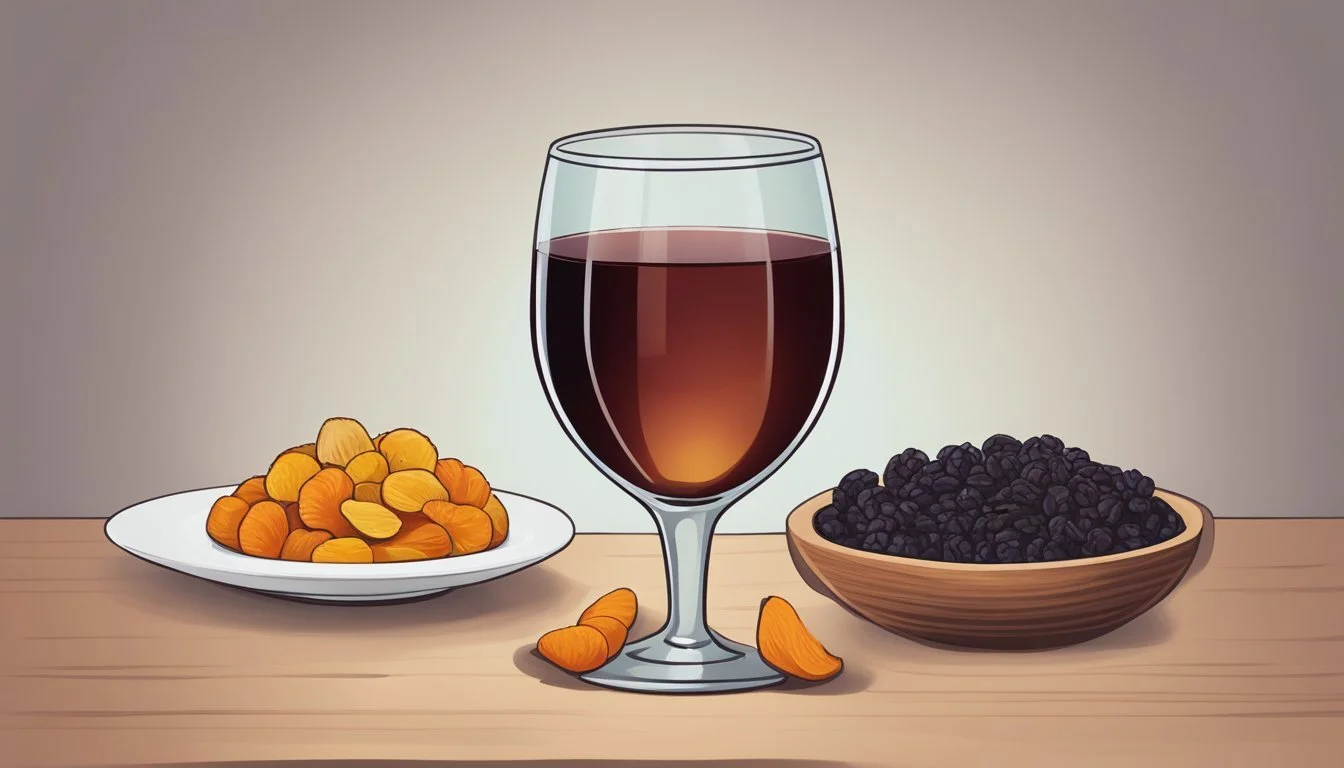Are Sulfites in Wine and Dried Fruit Harmful?
Unveiling the Truth About Preservatives
Sulfites are a group of compounds known for their preservative qualities, commonly added to various foods and beverages, including wine and dried fruits (What wine goes well with dried fruits?). Their function is of critical importance in preventing oxidation and maintaining product freshness. As a result, sulfites help prolong shelf life and enhance the appearance and taste of these items. In the case of wine, sulfites are naturally occurring to some extent due to the fermentation process but are often added to stabilize the wine and protect it from spoilage and bacterial growth.
Despite their pervasive use, sulfites have garnered attention for their potential to cause adverse reactions in certain individuals. While the majority of the population can consume sulfite-containing products without effects, a small percentage may experience symptoms ranging from mild allergies to severe asthmatic responses. This has led to a public inquiry into their safety and the impact on health when consuming products like wine and dried fruits (What wine goes well with fruit?), where sulfites are typically found in higher concentrations. It's important to clarify, however, that for the vast majority, sulfites are safe to consume within the regulatory limits set by food safety authorities.
The belief that sulfites in wine and dried fruits significantly contribute to adverse effects such as headaches or exacerbate hangovers has gained traction among consumers. However, scientific evidence does not consistently support these claims. Red wines, for example, typically contain less sulfite than their white counterparts, yet the misconception persists that red wine is more likely to cause sulfite-related headaches. Moreover, foods such as dried fruits contain high levels of sulfites to preserve their color and prevent spoilage, but they do not universally lead to reactions in consumers. Thus, it seems these effects may be overestimated and not as closely linked to sulfite levels as is often believed.
Understanding Sulfites
Sulfites are chemical compounds that serve as preservatives, protecting food and beverages against spoilage. In the sections below, we will explore the specific roles sulfites play in winemaking and dried fruit preservation.
The Science of Sulfites
Sulfur dioxide (SO2) is the most common form of sulfite used in food preservation. It exhibits antioxidant and antimicrobial properties, which make it highly effective at preventing oxidation, maintaining color, and protecting against microbial growth. Chemically, sulfites can prevent spoilage and preserve the freshness of food products by releasing sulfur, which acts as a preservative.
Sulfites in Winemaking
In winemaking, sulfites ensure the final product's quality and longevity by inhibiting unwanted bacteria and yeasts. Sulfur dioxide helps in:
Protecting the wine against oxidation, preserving both its color and flavor
Maintaining the wine's overall balance by preventing the growth of harmful microorganisms
The amount of sulfites in wine can vary, but the maximum legal limit in the United States is 350 mg/l. Dry red wines typically contain around 50 mg/l sulfites. The need for sulfites increases with lower acidity in wines; higher acidity provides a more stable environment, reducing the requisite amount of sulfites.
Sulfites in Dried Fruits
For dried fruits, sulfites perform a crucial role in:
Preventing browning and loss of vitamins which can happen due to exposure to air.
Extending the shelf life by acting as an antimicrobial, keeping fruits free from spoilage.
Sulfites are often added to a variety of dried fruits to preserve their appealing and vibrant appearance. Just like with wines, the quantity added is regulated to ensure safety for consumption, while being effective in preservation.
Health and Sulfites
Sulfites are widely used as preservatives in various food items including wine and dried fruits. Concerns around their impact on health have led to a critical examination of their effects, particularly for those with sensitivities and allergies.
Sensitivity and Allergies
Individuals with asthma might be at a heightened risk for sulfite sensitivity. For them, ingesting sulfites can trigger an array of adverse reactions, ranging from mild to severe. Although only a small percentage of the population is sulfite-sensitive—approximately 1% of the general population and 3-10% among asthmatics—these individuals can experience symptoms such as wheezing, hives, and in rare cases, anaphylaxis, which is a potentially life-threatening reaction.
Possible Health Effects
Contrary to common beliefs, sulfites are not usually responsible for headaches and hangovers associated with wine consumption. However, sensitive individuals might experience adverse effects after consuming products containing sulfites. These effects can include allergic reactions and histamine reactions, which can cause symptoms similar to an allergy attack. In general, sulfites are considered safe for the majority of the population, but those with hypersensitivity should remain cautious.
FDA Regulations on Sulfites
The FDA classifies sulfites as generally recognized as safe (GRAS), but mandates that foods containing more than 10 parts per million (ppm) of sulfites must list them on the label. This regulation assists individuals with sulfite sensitivity or allergies to avoid such foods. The enforcement of these regulations ensures that consumers are informed and can manage their sensitivity or allergy to sulfites effectively.
Sulfites in the Winemaking Process
Sulfites are integral to winemaking, serving as protectants and stabilizers throughout various stages. They play a critical role in controlling fermentation and oxidation, and their use differs between red and white wine production.
Role in Fermentation
In the fermentation process, sulfites help to prevent the proliferation of unwanted yeast strains and bacteria. Winemakers precisely add sulfur dioxide to control these microorganisms, ensuring a clean and successful conversion of grape sugars into alcohol. This step is essential to achieve the desired taste and quality in the finished wine.
Protection against Oxidation
Sulfur dioxide, a common form of sulfite, acts as a powerful antioxidant. By protecting wine from oxidation, it preserves the wine's color and flavor profile. Without sulfites, wine is prone to spoilage and may develop an undesirable taste and appearance due to exposure to air.
Sulfites in Red vs. White Wine
The level of sulfites present in wine can vary based on the type. Typically, white wines contain higher amounts because they are more susceptible to oxidation than red wines. Red wine, with its higher tannin content, has more natural antioxidants, requiring less sulfur dioxide. Conversely, white wine, lacking these tannins, rely more on sulfites for preservation. While organic and natural wines may have lower sulfite content, they still contain naturally occurring sulfites produced during fermentation.
Labeling and Consumption
Consumers often look to labels on wine and food products to inform their purchasing decisions, particularly when it involves the presence of sulfites. Understanding the specifics of labeling regulations and the ability to identify sulfites in food are essential for those who are sensitive to these additives or simply wish to be informed about what they consume.
Understanding Wine Labels
Wine labels are subject to strict regulations that mandate the disclosure of ingredients and preservatives, including sulfites. In the United States, a wine containing more than 10 parts per million (ppm) of sulfites must display the label "Contains Sulfites". The alcohol content is also prominently featured on wine labels, providing additional information about the product. Consumers interested in alternatives to conventional wines can seek out organic, biodynamic, or sulfite-free wines. These often have lower levels of sulfites or none at all, adhering to different production standards and regulations.
Identifying Sulfites in Foods
For other foods, labels must indicate the presence of sulfites if they are used at amounts of 10 ppm or higher. Due to their properties as preservatives, sulfites are commonly found in:
Dried fruits (e.g., apricots, prunes, raisins)
Processed foods
Snacks like potato chips
Condiments and sauces
Pickles and olives
Some fresh or frozen vegetables
Sulfites help in maintaining food color, prolonging shelf-life, and preventing the growth of bacteria. Consumers can typically find sulfite information on the ingredient list of food labels, which can be particularly important for those with asthmatic conditions, as a small percentage may exhibit sensitivity to sulfites.
Tips for Sulfite Management
Managing sulfites effectively can enhance the shelf life and freshness of certain foods and wines. It requires an understanding of how sulfites work and their impact on various products.
Choosing Wines with Lower Sulfites
When selecting wines, one should consider that red wines typically contain fewer sulfites than white wines. The lower sulfite content is due to the tannins in red wine that possess natural antioxidant properties. Moreover, organic wines or those labeled "no added sulfites" limit the winemaker's use of sulfites, although they may still contain naturally occurring sulfites. Opting for wines with a higher alcohol content can also be beneficial since these require less added sulfites to preserve freshness.
For individuals sensitive to sulfites, they may prefer dry wines over sweet wines or dessert wines, as the latter often have higher sulfite levels to prevent fermentation and spoilage. Brands like Taylor may carry varieties with lower sulfite concentrations, making it imperative for consumers to read labels carefully.
Storing and Handling Sulfite-rich Foods
Proper storage of foods rich in sulfites is crucial for maintaining quality. Foods like dried apricots, which typically contain sulfites such as sodium sulfite or sodium bisulfite to preserve color, must be kept in airtight containers to prevent oxidation. Nuts, often treated with sulfites to retain freshness, should be stored in a cool, dry place and consumed before the expiration date to ensure optimal flavor and texture.
For wines, consistent temperature control and minimizing exposure to oxygen can extend their shelf life, even after opening. This can be achieved by using wine preservers that remove air from the bottle or storing the wine in the fridge with a proper stopper.
Exploring Alternatives and Solutions
In the realm of winemaking and dried fruit preservation, there is a growing interest in alternatives to sulfites due to health concerns and consumer preferences. This section delves into viable substitutes and emerging practices that aim to reduce or eliminate the use of sulfites while maintaining quality and safety.
Alternatives to Sulfites
Natural Wine: Natural winemakers often opt for minimal intervention, which means little to no added sulfites. They primarily rely on the naturally occurring sulfur dioxide in grapes to act as a preservative. However, these wines may have a shorter shelf-life and different flavor profiles, and it's key for consumers to be aware of this trade-off.
Organic and Biodynamic Wine: Producers of organic wine use strictly regulated amounts of sulfites, far lower than conventional wines, whereas biodynamic wines incorporate holistic farming practices, which can include even stricter sulfite regulations. They use natural yeast and follow the biodynamic calendar for planting, pruning, and harvesting.
Innovations in Equipment: The wine industry is exploring equipment that could potentially reduce the need for sulfites. This includes improved filtration systems, oxygen management technology, and the use of inert gases to prevent oxidation, a key factor in the need for sulfites.
The Future of Winemaking
Funding for Research: There's a clear necessity for more extensive research into alternatives. Funding is being directed towards studying the efficacy of different preservative methods in winemaking that could replace or reduce sulfites without compromising safety or quality.
Preservative Advances: Scientists and winemakers are working together to discover and refine alternative preservatives that can provide the same level of protection as sulfites. Potential solutions include ascorbic acid, essential oils, tannins, and other natural extracts known for their antimicrobial properties.
Through these efforts, the wine industry is embracing change to meet consumer demand for wines with lower levels of sulfites and the industry's need for effective preservation techniques.





